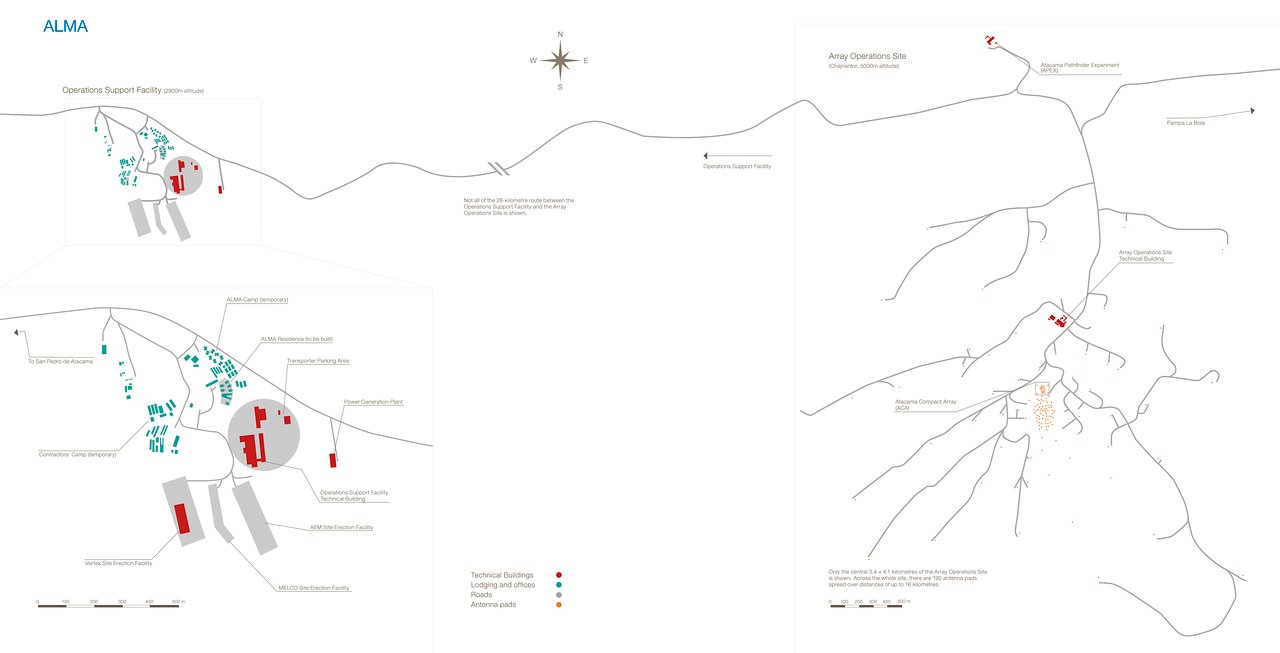ALMA
In search of our cosmic origins
What is the Atacama Large Millimeter/submillimeter Array (ALMA)?
High on the Chajnantor plateau in the Chilean Andes, the European Southern Observatory (ESO), together with its international partners, is operating the Atacama Large Millimeter/submillimeter Array (ALMA) — a state-of-the-art telescope to study light from some of the coldest objects in the Universe. This light has wavelengths of around a millimetre, between infrared light and radio waves, and is therefore known as millimetre and submillimetre radiation. ALMA comprises 66 high-precision antennas, spread over distances of up to 16 kilometres. This global collaboration is the largest ground-based astronomical project in existence.
What is submillimetre astronomy?
Light at these wavelengths comes from vast cold clouds in interstellar space, at temperatures only a few tens of degrees above absolute zero, and from some of the earliest and most distant galaxies in the Universe. Astronomers can use it to study the chemical and physical conditions in molecular clouds — the dense regions of gas and dust where new stars are being born. Often these regions of the Universe are dark and obscured in visible light, but they shine brightly in the millimetre and submillimetre part of the spectrum.
Why build ALMA in the high Andes?
Millimetre and submillimetre radiation opens a window into the enigmatic cold Universe, but the signals from space are heavily absorbed by water vapour in the Earth's atmosphere. Telescopes for this kind of astronomy must be built on high, dry sites, such as the 5000-m high plateau at Chajnantor, one of the highest astronomical observatory sites on Earth.
The ALMA site, some 50 km east of San Pedro de Atacama in northern Chile, is in one of the driest places on Earth. Astronomers find unsurpassed conditions for observing, but they must operate a frontier observatory under very difficult conditions. Chajnantor is more than 750 m higher than the observatories on Mauna Kea, and 2400 m higher than the VLT on Cerro Paranal.
A Tour at the Chajnantor Plateau
|
Click on the image to take a Virtual Tour in and nearby Chajnantor. |
To visit the ALMA Site, please see Media Visits
Why is ALMA an interferometer?
ALMA is a single telescope of revolutionary design, composed initially of 66 high-precision antennas, and operating at wavelengths of 0.32 to 3.6 mm. Its main 12-metre array has fifty antennas, each measuring 12 metres in diameter, which together act as a single telescope — an interferometer. An additional compact array of four 12-metre and twelve 7-metre antennas complements this. The 66 ALMA antennas can be arranged in different configurations, where the maximum distance between antennas can vary from 150 metres to 16 kilometres, which gives ALMA a powerful variable “zoom”. It is able to probe the Universe at millimetre and submillimetre wavelengths with unprecedented sensitivity and resolution, with a vision up to ten times sharper than the Hubble Space Telescope, and complementing images made using the VLT Interferometer.
Science with ALMA
 ALMA is the most powerful telescope for observing the cool Universe — molecular gas and dust. ALMA studies the building blocks of stars, planetary systems, galaxies and life itself. By providing scientists with detailed images of stars and planets being born in gas clouds near our Solar System, and detecting distant galaxies forming at the edge of the observable Universe, which we see as they were roughly ten billion years ago, it lets astronomers address some of the deepest questions of our cosmic origins.
ALMA is the most powerful telescope for observing the cool Universe — molecular gas and dust. ALMA studies the building blocks of stars, planetary systems, galaxies and life itself. By providing scientists with detailed images of stars and planets being born in gas clouds near our Solar System, and detecting distant galaxies forming at the edge of the observable Universe, which we see as they were roughly ten billion years ago, it lets astronomers address some of the deepest questions of our cosmic origins.
ALMA was inaugurated in 2013, but early scientific observations with a partial array began in 2011. See press release eso1137 for more information.
ALMA has consistenly produced unique and spectacular results. The fields in which it has delivered its most outstanding results include:
- Providing images of protoplanetary disks such as HL Tau (see eso1436) which transformed the previously accepted theories about the planetary formation.
- Observing phenomena such as Einstein Rings in extraordinary detail (see eso1522), providing a level of resolution not acheived by the NASA/ESA Hubble Space Telescope.
- The detection of complex organic molecules — carbon-based, pre-biotic structures, necessary for building life — in distant protoplanetary disks (see eso1513), comfirming that our Solar System is not unique in potentially fostering life.
For more information on discoveries made with ALMA, explore the Science with ESO Telescopes page.
ALMA is a partnership between ESO, the U.S. National Science Foundation (NSF) and the National Institutes of Natural Sciences (NINS) of Japan in cooperation with the Republic of Chile. ALMA is funded by ESO on behalf of its Member States, by NSF in cooperation with the National Research Council of Canada (NRC) and the National Science Council of Taiwan (NSC) and by NINS in cooperation with the Academia Sinica (AS) in Taiwan and the Korea Astronomy and Space Science Institute (KASI).
ALMA construction and operations are led by ESO on behalf of its Member States; by the National Radio Astronomy Observatory (NRAO), managed by Associated Universities, Inc. (AUI), on behalf of North America; and by the National Astronomical Observatory of Japan (NAOJ) on behalf of East Asia. The Joint ALMA Observatory (JAO) provides the unified leadership and management of the construction, commissioning and operation of ALMA.
Science goals
Star formation, molecular clouds, early Universe.
More about the ALMA Observatory
- ALMA Antennas
- ALMA Transporters
- ALMA and Interferometry
- ALMA Residencia
- More interesting facts are available on the FAQs page
- Read more about this observatory on the ALMA Handout in PDF format
- More ALMA Image Archive and ALMA Video Archive are available in the ESO multimedia archive
- For scientists: for more detailed information, please visit our technical pages
- Visit the ALMA Observatory website
The ALMA Planetarium Show
"In search of our Cosmic Origins" is an inspiring show, introducing ALMA, the largest astronomical project in existence. Read more at the Cosmic Origins website.
ALMA Timelapse
View larger timelapseALMA Trailer
Download the ALMA trailer in the video archive.
ALMA
|
|
|
ALMA on Google Maps
The antenna icons in this image show — in real time — the location of the antennas at the Chajnantor plateau (AOS)
View larger map

